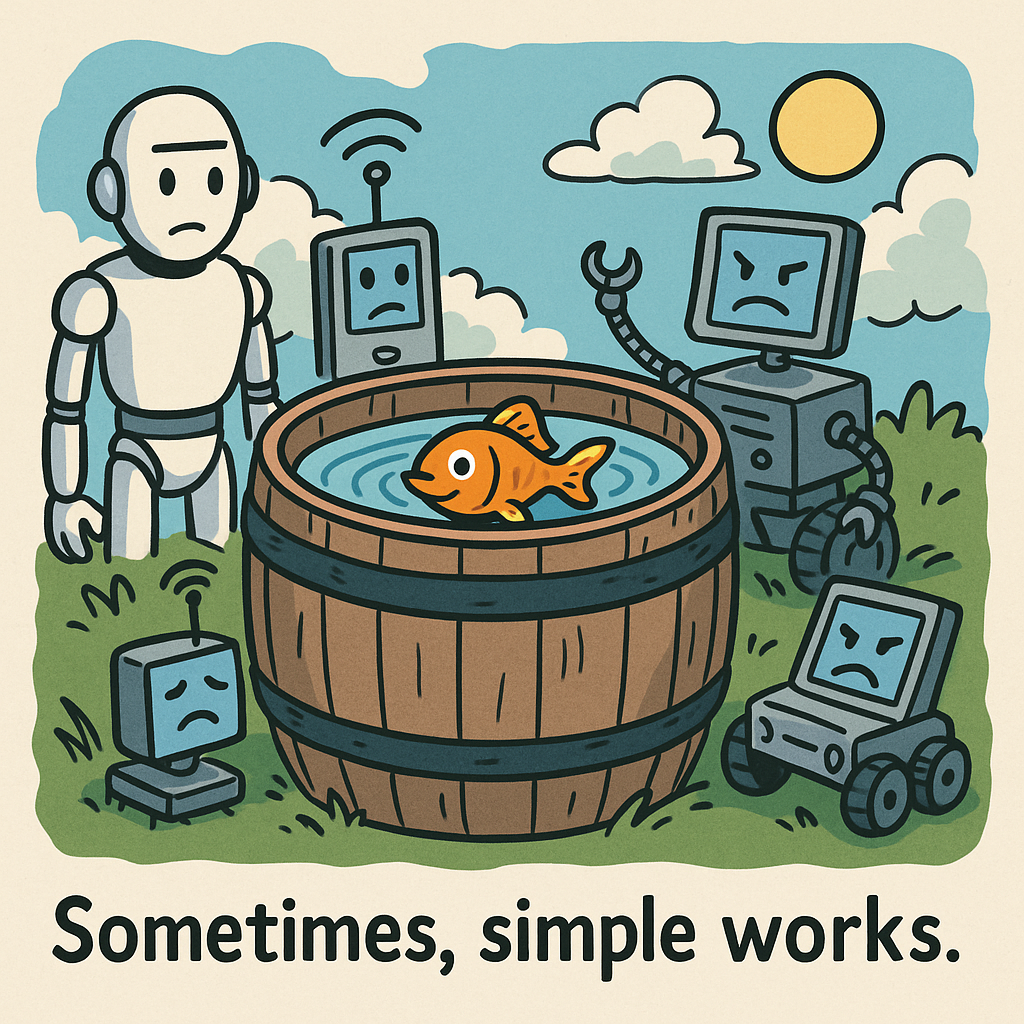🐟 Pacific Blue-Eyes, AI, and the Over-Engineering Trap
I stumbled across a beautifully simple idea the other day: placing native fish like Pacific Blue-eyes into rain barrels that collect overflow from water tanks to stop mosquitoes breeding.
It’s a classic Aussie summer dilemma: you want to store rainwater for your garden, but standing water becomes a mozzie nursery. And with climate change and water restrictions, more people are collecting water than ever.
Instead of nets, larvicides, or electric zappers, the solution? A few little fish.
No sensors. No subscriptions. No smart home integration.
Just biology doing what it’s always done. Fish eat larvae. Water stays usable. The garden thrives.
It got me thinking…
🧠 Modern world, ancient wisdom
We’ve drifted from nature’s systems and started solving simple problems in complex, often expensive ways.
Take mosquitoes. Around the world, we’ve invested millions into highly engineered solutions for what is, in many everyday contexts, a basic household issue.
- 🛰️ In California, over $7 million was spent using drones and satellite imaging to identify mosquito hotspots
- 🧬 In Florida, biotech firms released millions of genetically modified mosquitoes after years of R&D and high costs
- 🤖 In Singapore, autonomous “mozzie hunter” robots were deployed to spray larvicide in hard-to-reach drains. This is a clever fix, but one that addresses the symptom (larvae in drains) instead of asking why water is stagnating there in the first place
All fascinating. All innovative. But often, these solutions are focused on the visible problem, not the root cause. They’re treating the result, not the conditions that created it.
Sometimes we chase complex solutions because they look impressive or feel safer than confronting the real issue.
And this pattern extends beyond mozzies.
- 🇦🇺 Here in Australia, we’ve seen major investments in digital tools like COVIDSafe and My Health Record. These platforms promised a lot but struggled with real-world uptake. Too often, they were top-down responses that engineered around complexity instead of addressing the underlying challenges of trust, integration, and human behaviour.
Whether it’s public health or pest control, we keep reaching for sophisticated answers when simpler, system-aware thinking might be more effective.
💻 Now apply that to delivery and AI…
We’re seeing the same story in project delivery and the rise of AI.
We’re implementing automation and analytics to tackle issues that might be better solved with a whiteboard and a conversation.
We:
- Use AI to sort through bloated backlogs instead of asking why they’re bloated
- Build chatbots for customer complaints instead of fixing the thing people are complaining about
- Implement complex dashboards instead of aligning teams on what actually matters
It’s not that the tech is wrong. It’s that we’re using it to treat symptoms, not causes.
🔁 Symbiosis, not substitution
I love technology. I work in tech. But it’s only as good as the system it’s plugged into.
Sometimes, what’s needed isn’t innovation. It’s reconnection. Reconnection with natural rhythms, human behaviour, and smart design.
Sometimes what’s missing isn’t a new platform. It’s the basics of good process design. Simplicity. Clarity. Flow. And putting the real end-user at the centre.
Sometimes the smartest solution is the fish in the barrel.
Low-cost. Self-regulating. Effective.
👇 Three questions for the week ahead:
- Where am I overcomplicating?
- What would the “Pacific Blue-eye” version of this problem look like?
- Am I solving the right problem at all?
If these kinds of questions resonate, it’s the kind of work I love. Helping teams find elegant, effective answers to problems that don’t need to be overbuilt.
Happy Monday.







